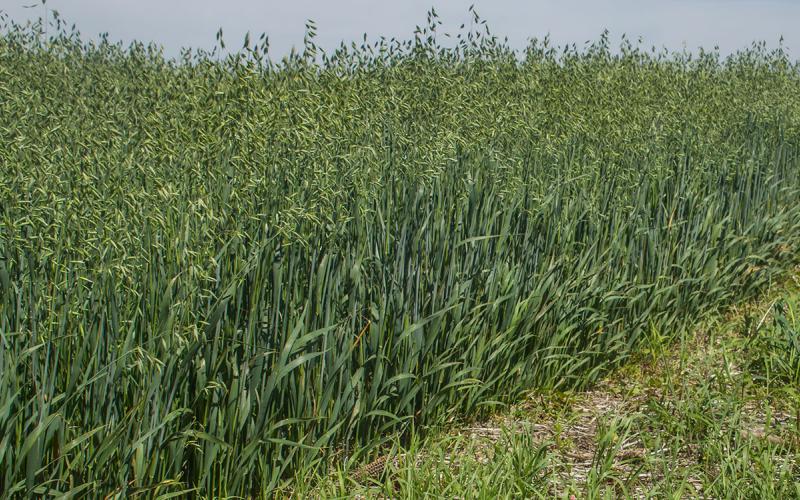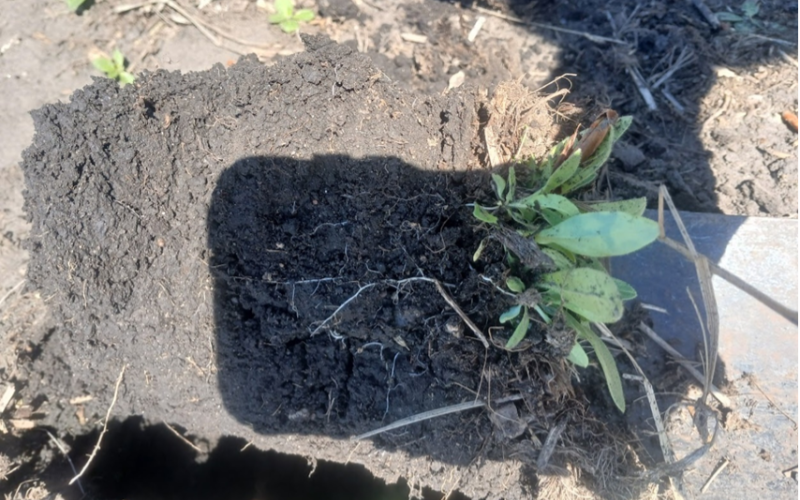Introduction
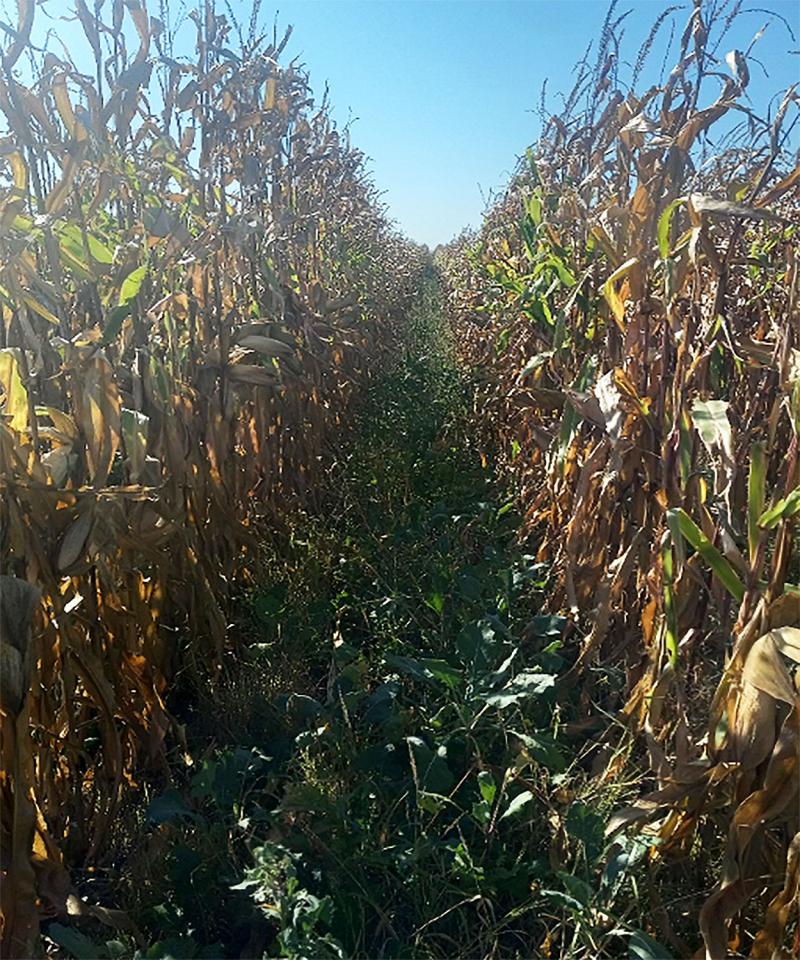
Corn is the most commonly grown crop across the Midwest, including South Dakota. However, growing corn in this region takes up much of the growing season, which leads to limited time and unfavorable conditions for cover crops to grow during the fallow period between corn harvest and planting the following crop. Cover crops are typically planted by drill post-harvest and terminated a few weeks prior to planting the following crop. The limited time available for cover crops to grow leads to limited cover crop biomass production (<1000 lbs. dry matter/acre). Cover crop biomass production throughout this article is discussed as lbs. dry matter/acre. Usually, greater cover crop biomass production leads to greater improvement in soil health and can provide greater additional forage for livestock to graze (Van Eard et al., 2023; Blanco-Canqui et al., 2020; McClelland et al., 2021). Also, cover crop species selection is limited due to only winter hardy species, such as cereal rye, triticale, winter wheat, hairy vetch and winter camelina, which can produce significant biomass. Many producers are interested in incorporating cover crops into their cropping systems, but they would like to see significant biomass production to provide cover on the soil surface and short-term improvements in soil health. This has led to investigating the method of inter-seeding cover crops into corn. A recent review article was published in the journal Agronomy on biomass production and the effects of inter-seeding cover crops into corn on biomass production, grain yields, and other ecosystem services provided by the cover crop. A picture of cover crops inter-seeded into wide row corn is shown in Figure 1.
Corn Growth Stage
Planting the cover crop at the right growth stage of corn growth is important to allow the cover crop establishment. Having adequate light getting through the crop canopy is important to establish the cover crop. It would be expected that planting the cover crop earlier in the growing season prior to the corn canopy closing would produce the most biomass. Indeed, averaged across studies and cover crop species, planting the cover crop during the earlier growth stages of corn produced more biomass (Figure 2). Inter-seeding the cover crop into corn at planting (V0) and at V4 growth stage produced the most fall cover crop biomass (Figure 2). Generally, less fall biomass was produced as the cover crop was planted during later stages of corn growth (Figure 2). This is likely due to there being a longer time for the cover crop to grow during the summer when it is inter-seeded at earlier crop growth stages. Figure 3 shows spring cover biomass production from cover crops planted at different corn growth stages that over wintered where they were planted. Planting the cover crop at R6 stage (physiological maturity or black layer) produced the most spring cover crop biomass. Spring cover crop biomass production was slightly higher than fall cover crop biomass production when the cover crop was planted at different corn growth stages. It is worth noting that winter hardy cover crops. such as cereal rye, winter camelina, or pennycress. were more often planted during the later reproductive stages, whereas a wider variety of species were planted earlier in the season. Studies included in this review were from all over the United States, and some of the species that overwintered at the study location may not overwinter in South Dakota.
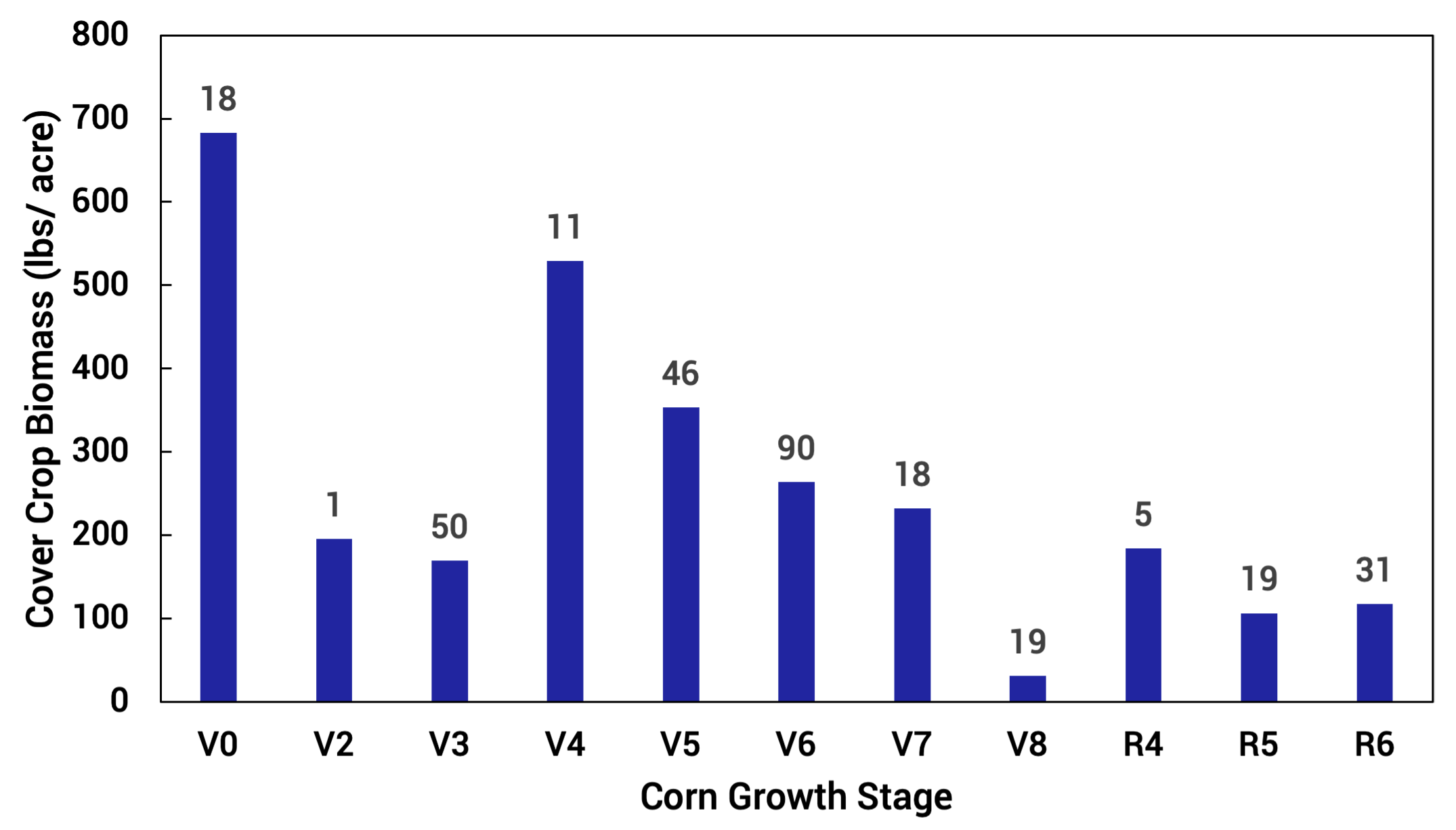
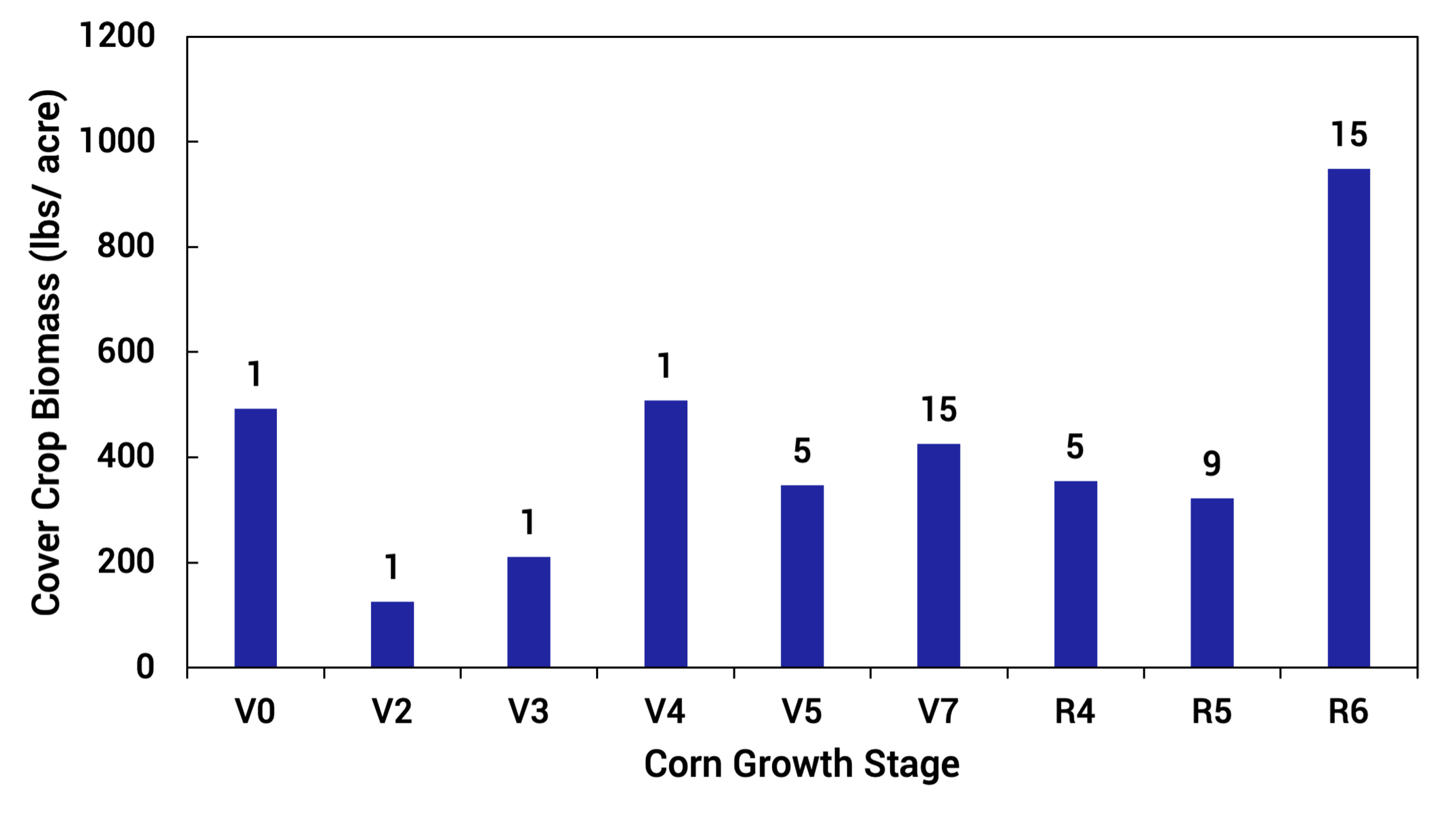
Cover Crop Species
When planting cover crops into corn, some species may perform better growing under the canopy of the corn crop. Many different species of cover crops have been inter-seeded into corn, which are shown in Figure 4 and 5. Of the species or mixtures that were commonly planted, a mixture with four or more species produced the most fall biomass (Figure 4). Most of the individually planted cover crop species produced low levels of fall biomass when inter-seeded into corn (100 to 300 lbs. of dry biomass per acre) (Figure 4). Cover crop species that overwintered produced more biomass than species that were terminated by frost. Many of the cover crop species that overwintered produced an average cover crop biomass between 600 and 1200 lbs. of biomass per acre, which was greater than fall biomass production from most of the cover species. This suggests that inter-seeding winter-hardy cover crops can produce more biomass, return more organic matter to soil, and provide more cover on the soil surface.
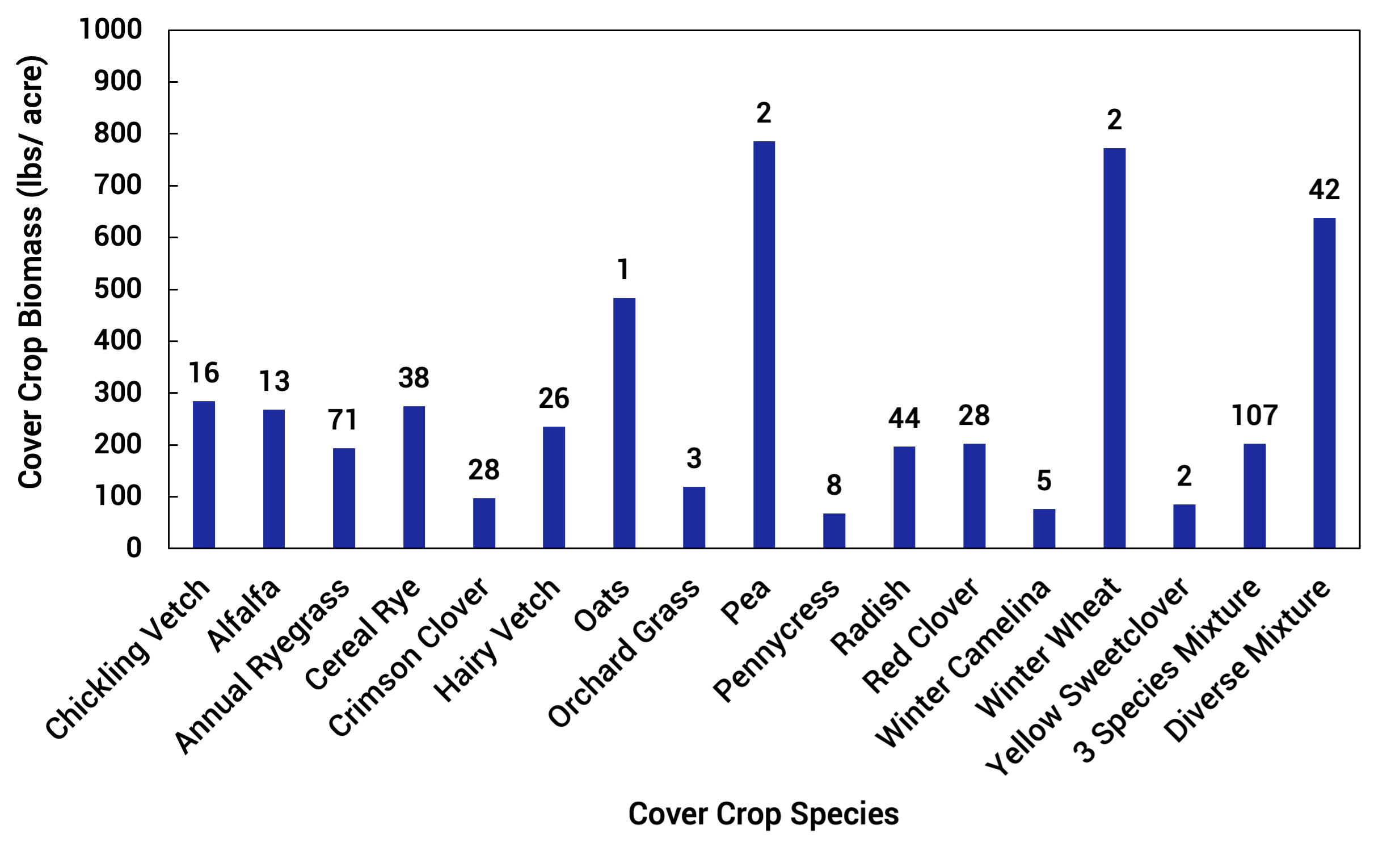
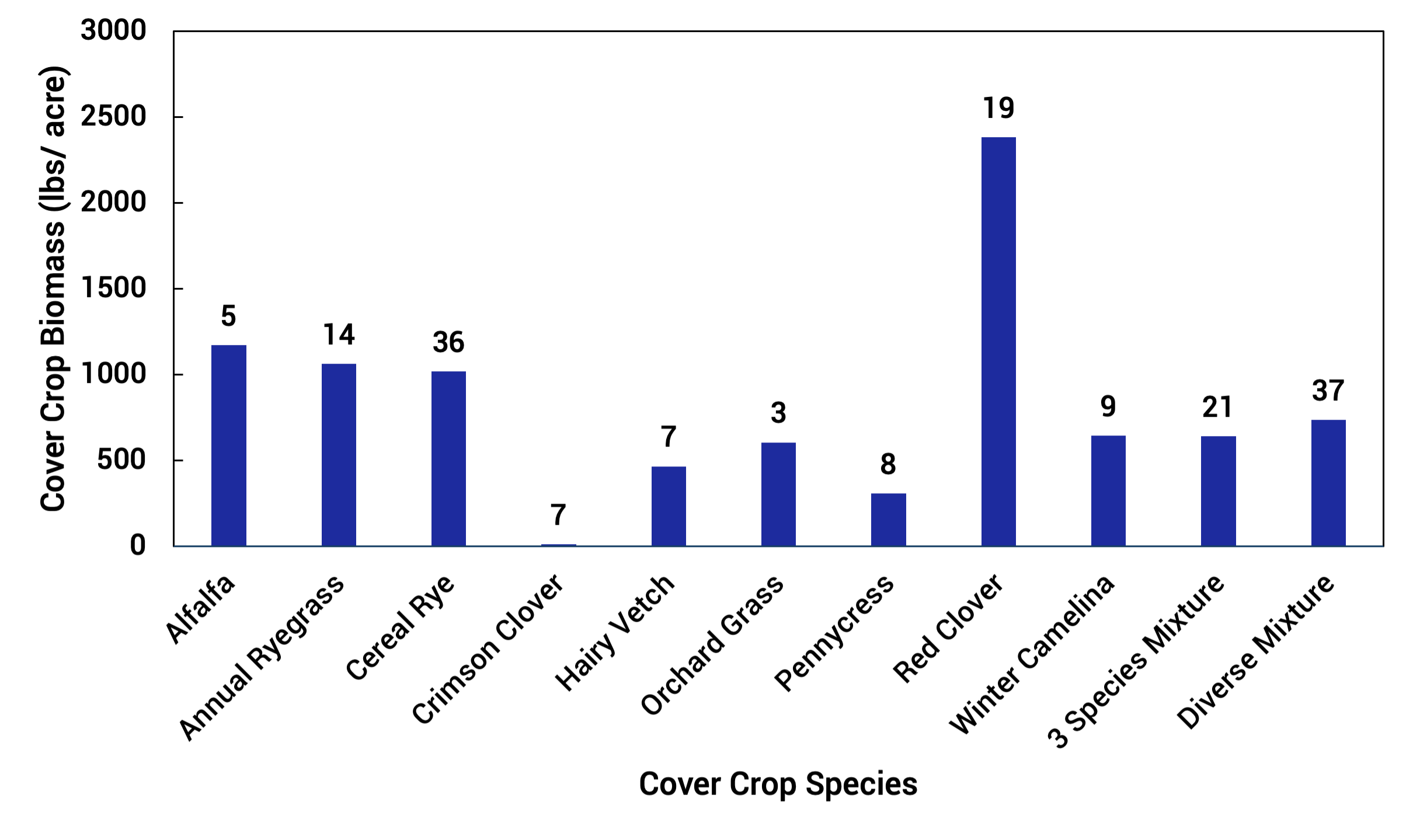
Other Factors That Affected Cover Crop Biomass Production
Other factors, including planting method, average annual precipitation and temperature, cover crop seeding rate, corn seeding rate, and row spacing were analyzed. Fall cover crop biomass production was not affected by average annual precipitation, but spring biomass production was greater, as average annual precipitation increased. Average spring cover crop biomass production was 125 lbs./acre when average annual precipitation was less than 19.8 inches, 638 lbs./acre when average annual precipitation was between 19.8 and 29.6 inches, 758 lbs./acre when average annual precipitation was between 29.6 and 39.4 inches, and 1649 lbs./acre when average annual precipitation was > 39.4 inches. As with average annual precipitation, fall biomass production was not affected by temperature class, but as average annual temperature increased, spring cover crop biomass increased. Average spring cover crop biomass production was 303 lbs./acre when average annual temperature was less than 42.8 degrees Fahrenheit, 749 lbs./acre when average annual temperature was between 42.8 degrees Fahrenheit and 50 degrees Fahrenheit, and 1179 lbs./acre when average annual temperature was greater than 50 degrees Fahrenheit. This shows that more-favorable conditions for cover crop biomass production (> precipitation and temperature) generally increased spring cover crop biomass production when cover crops were inter-seeded into corn. Planting method and cover crop seeding rate did not have a consistent effect on cover crop biomass production when averaged across studies.
Corn Seeding Rate
Two studies looked at the interaction between corn seeding rate and cover crop biomass production (Youngerman et al., 2018 and Baributsa et al., 2008). These two studies found that fall cover crop biomass production was higher when corn was planted at lower seeding rates (15020 seeds/acre and 15182 seeds/acre) than at higher seeding rates (30364 and 45020 seeds/acre). In the study in Michigan that measured spring cover crop biomass production from red clover, corn seeding rate did not affect spring cover crop biomass production. However, at the lowest seeding rate, corn yield was less than at higher seeding rates in many of the treatments in these two studies.
Row Spacing
Row spacing also influenced cover crop biomass production averaged across studies. Although there were only three published papers that analyzed cover crop biomass production in 60-inch corn (Goettl et al., 2024; Black 2023; Hines et al., 2023). The average fall cover crop biomass was 1029 lbs./acre when inter-seeded into 60-inch corn and 246.4 lbs./acre when inter-seeded into 30-inch corn. Spring cover crop biomass production was not measured when cover crops were inter-seeded into wide-row corn. However, wide row corn yielded slightly less than corn planted at 30-inch row spacing.
Effect of Planting Date and Cover Crop Species on Grain Yield
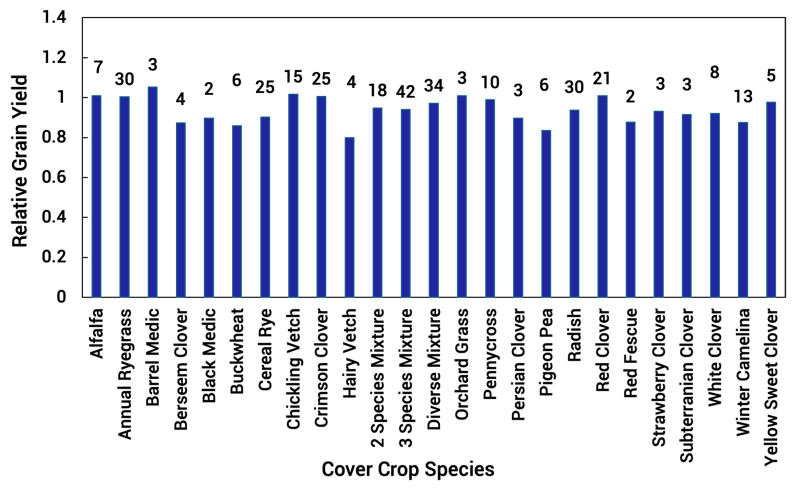
Inter-seeding some cover crop species or a mixture of species may provide symbiotic benefits to corn grain yield, whereas some other species may negatively affect corn grain yield.
Relative grain yield is compared to the no-cover-crop control in the studies with weed control.
Most of the individual cover crop species or mixtures did not affect corn grain yield. However, some species, such as cereal rye, berseem clover, buckwheat, hairy vetch, radish, and winter camelina, tended to reduce corn grain yield. None of the cover crop species increased corn grain yield.
Selecting species or mixtures that do not affect corn grain yield, while optimizing cover crop biomass production, is important to maximize benefits provided to the soil from the cover crop.
Growth Stage
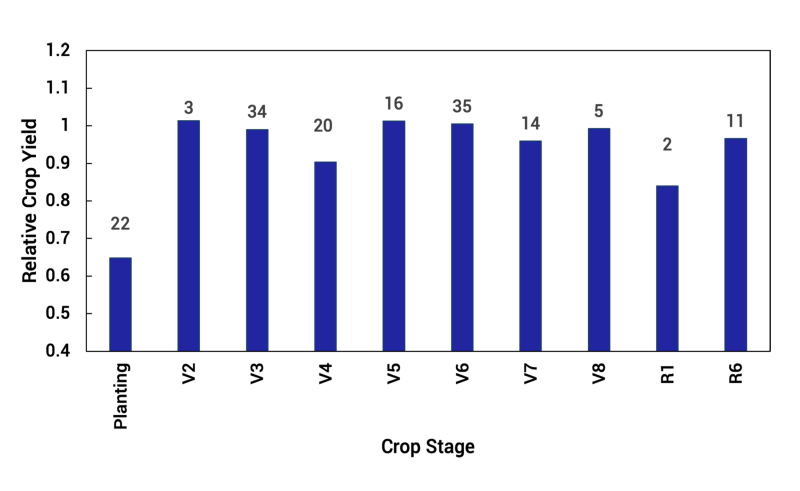
The growth stage that the cover crop is planted into corn may also influence corn grain yields. The cover crop may compete with corn for water and nutrient resources, which may affect crop grain yield. Planting the cover crop after the critical weed-free period for corn can prevent a negative effect to the corn grain yields from the inter-seeded cover crop. During the early vegetative stages of corn growth, other plants growing in corn rows may have a negative effect on corn growth. The effect of corn growth stage when planting cover crops on corn grain yield was compared and averaged across cover crop species. Planting cover crops at planting and during early vegetative stages of corn growth tended to reduce yields. However, inter-seeding cover crops at reproductive stages of corn growth did not affect corn grain yield.
Effects on Weed Control
One mutual benefit that cover crops can provide is to suppress undesirable weeds while the corn crop is growing. Averaged across studies included in this review, inter-seeding cover crops into corn reduced weed biomass from 715 lbs./acre with no weed control to 245 lbs/ acre. Cover crops performed better at suppressing weeds when planted after corn planting than prior to planting. Also, certain cover crop species did not perform better or worse at suppressing weeds when they were inter-seeded into corn, although some think that cereal rye is a good cover crop for suppressing weeds. This shows some benefit to the agroecosystem from the inter-seeded cover crop.
Effects on Soil Properties
A common purpose of planting cover crops is to improve soil health. All the inter-seeding studies found in this review did not inter-seed cover crops for more than four years. In many of the instances, inter-seeding cover crops for a year or two did not affect many of the soil properties that previous studies measured. Many studies found that inter-seeded cover crops reduced soil nitrate concentration in the fall or following spring. This most frequently happened when grass cover crop species were planted. Interestingly, inter-seeded cover crops did not reduce soil water content. Many would assume inter-seeding cover crops would reduce soil water content while the cover crops are growing along with the corn. The limited effect of inter-seeded cover crops on soil properties after planting them for a year or two may be due to limited biomass production and additional carbon added to the soil. To improve soil health, cover crops likely need to be included in the cropping system for a longer period of time.
Methods to Inter-Seed Cover Crops Into Corn
Inter-seeding cover crops into corn may be a way to enhance cover crop performance in cropping systems where there is limited moisture and the temperature is cold between the harvest of the corn crop and planting the following crop, such as soybeans. Inter-seeding cover crops requires alternative planning equipment compared to post harvest planting with a grain drill. If cover crops are planted at the same time as planting corn, they may be planted with a grain drill parallel with corn rows. However, some of the previous studies found that planting the cover crop at the same time as corn planting may reduce corn grain yields. Damage caused to corn yields from cover crops is not covered by crop insurance, and you should check with your agent before inter-seeding.
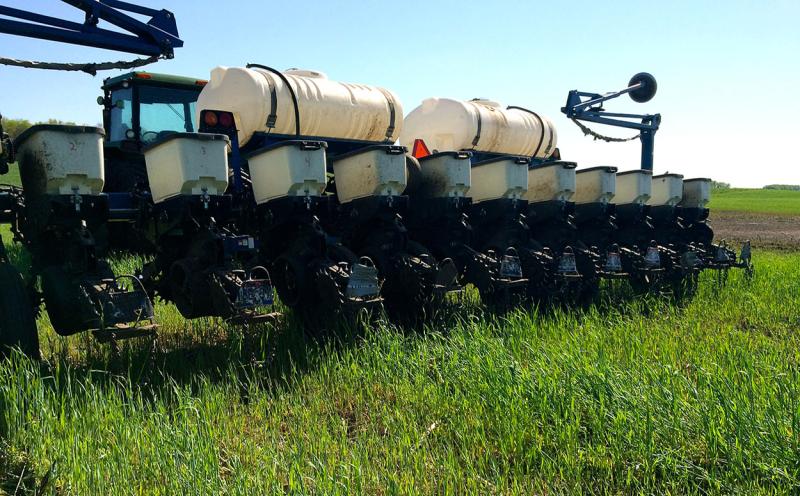
Inter-seeding cover crops should be done at the V6 stage or later due to there being no affect on grain yields. During vegetative corn growth stages, cover crops can be inter-seeded using a drill or by broadcast seeding. Drills have been customized that have gaps where the corn rows are to specifically inter-seed cover crops into corn plantings. Cover crops also can be broadcast seeded during the vegetative stages using a variety of techniques to spread the cover crop seed, including a broadcast seeder attached to a tractor, plane, drone, or helicopter. To inter-seed cover crops into later stages of corn growth (reproductive stages) there is a more-limited amount of methods that can be used to plant the cover crop. The most-common way cover crops are inter-seeded during the later stages of corn growth is by aerially applying them from a plane, helicopter, or drone. To do this, it usually requires hiring a custom applicator. Cover crops can also be applied from a high-clearance sprayer using a broadcast spreader or by applying through drops during the reproductive stages.
Species Selection
Cover crop species to inter-seed should be selected based upon location, time of year and cropping system. If planting cover crops during vegetative stages, species can be selected that will be terminated in fall by frost or are winter hardy. Common cover crop species that are planted during the early vegetative stages of corn growth include annual ryegrass, cereal rye, clover species, alfalfa, and radish. Shade tolerance of species is important so that the cover crop can survive and produce some biomass while growing underneath the corn crop canopy. Some of these species will winter kill by frost, whereas some of the other species may overwinter. If the cover crop overwinters, it can produce additional biomass the following spring. When inter-seeding cover crops during the later vegetative stages of corn growth, planting species that will overwinter is the best to optimize benefits provided from the cover crop. Species, such as cereal rye, winter camelina, hairy vetch, and clovers, are good species to plant during the reproductive stages. If planting the cover crop by drill, it should be planted at the recommended seeding rate (Licht 2019). When broadcasting the cover crop, it is recommended to plant the cover crop at a 15 to 25 % higher seeding rate than when drilling the cover crop (Licht 2019; NRCS 2010).
Herbicide Selection
Also, if you are planning on inter-seeding cover crops, herbicide selection is important. If a residual herbicide is used, it may have a negative effect on the cover crop or some of the cover crop species that are going to be planted. Herbicide labels should be carefully read prior to application if planning on inter-seeding cover crops. If some of the cover crop species are not recommended to be planted until the next year or 18 months after application, the herbicide should not be applied if the producer plans on inter-seeding. Also, cover crop species should be planted that will not be negatively affected by herbicides applied to the cropping system.
Summary
Inter-seeding is a method to incorporate cover crops into corn-based cropping systems. Based off a summary of previous studies, planting species that would be terminated by frost during the early vegetative stages produced less fall biomass than planting winter-hardy species that will overwinter. Also, planting cover crops after the V4 stage generally did not affect corn grain yield. Mixtures did not affect corn grain yield but produced the most fall biomass compared to individual species. Inter-seeding cover crops for a year or two had limited effects on soil properties. Cover crops can be both drill and broadcast planted at early stages of corn growth, whereas they can only be broadcast seeded during the later stages of corn growth.
References
- Baributsa, D.N.; Foster, E.F.; Thelen, K.D.; Kravchenko, A.N.; Mutch, D.R.; Ngouajio, M. 2008. Corn and cover crop response to corn density in an interseeding system. Agron. J. 2008, 100, 981–987.
- Black, K.L.; Wells, S.; Johnson, G.A.; Lazarus, W.F.; Kraus, A. 2023. Interseeding Wide-Row Corn with Forage Cover Crops: Investigating System Potential for Expanded Economic Opportunities in Corn Production Systems. Agronomy, 13, 307.
- Blanco-Canqui, H.; Ruis, S.J. Cover crop impacts on soil physical properties: A review. Soil Sci. Soc. Am. J. 2020, 84, 1527–1576.
- Goettl, B.; Anderson, B.; DeSutter, T.; Franzen, D.; Wick, A. 2024. Interseeded cover crops in wide-row corn: An opportunity for northern cropping systems. Crop, Forage and Turfgrass Management., 10, e20268.
- Hines, S.; Packham, J.; Loomis, G.; Thomas, J.; Adjesiwor, A. 2023. Impacts of interseeding cover crop into silage corn grown on wide row spacings. Journal of the National Association of County Agricultural Agents. 2023, 16.
- Licht, M. 2019. A look at cover crop seeding methods. Iowa State University Extension and Outreach
- McClelland, S.C.; Paustian, K.; Schipanski, M.E. Management of cover crops in temperate climates influences soil organic carbon stocks: A meta-analysis. Ecol. Appl. 2021, 31, e02278.
- NRCS. (2010). Aerial seeding of cover crops. Illinois Agronomy Technical Note No. 21 Natural Resources Conservation Service.
- Van Eerd, L.L.; Chahal, I.; Peng, Y.; Awrey, J.C. Influence of cover crops at the four spheres: A review of ecosystem services, potential barriers, and future directions for North America. Sci. Total Environ. 2023, 858, 159990.
- Youngerman, C.Z.; DiTommaso, A.; Curran, W.S.; Mirsky, S.B.; Ryan, M.R. Corn density effect on interseeded cover crops, weeds, and grain yield. Agron. J. 2018, 110, 2478–2487.

